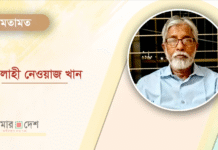
Nazmul Biswas (28) of Khulna went to Qatar, hoping to change his family’s financial condition.
With the same dream, Golam Mustafa (26) of Cumilla went to Saudi Arabia, and Rabiul Awal (31) of Narayanganj went to Dubai.
Additionally, 45,301 migrant corpses arrived in Bangladesh between 2008 and June of 2022. Of these, 27,231 bodies (63 percent) arrived from six countries in the Gulf. Among them, 12,930 came from Saudi Arabia alone. Besides, 5,123 corpses came from the United Arab Emirates, 3,776 from Oman, 2,724 from Kuwait, 1,011 from Bahrain, and 1,562 from Qatar. Many more Bangladeshi migrants who died abroad were buried locally for various reasons, especially in Saudi Arabia.
Before this, between 2003-2007, 6,017 dead bodies of migrant workers had arrived. Earlier, in 2002, the airport had information about the arrival of 3,613 dead bodies. In total, 54,931 migrant worker corpses are estimated to have come in so far.
The death of migrant workers in Qatar, the country hosting the 2022 FIFA World Cup, has been globally criticised. But there has been overwhelming silence over the deaths of workers in the other Gulf countries.
According to data from Dhaka’s Shahjalal International Airport, an average of 8-10 bodies arrive daily. According to documents, most migrants who are middle-aged or young, die of brain stroke – other causes include heart disease, accidents at work, road accidents, suicide, etc.
According to migrants, relatives of the dead, and experts, the temperature in the Gulf Cooperation Council (GCC) countries is too hot for the migrants to handle. Unskilled or low-skilled Bangladeshis are involved in risky and difficult laborious jobs in harsh weather. The hostile environment, 12-18 hours of inhumane daily work, poor living conditions, separation from relatives for a long time, and mental stress, usually cause stroke or heart attack.
Anyone can observe the cargo gate area of Dhaka’s airport, where bodies in coffins are handed over to the families. There are no seating arrangements or toilets for the waiting families. And when they finally see the dead bodies of their loved ones, many cannot handle it. Thus, their suffering has no end.

Qatar spent more than USD 200 billion on eight new stadiums, airports, roads, and modern public transport systems for the 2022 FIFA World Cup. For this, the country needed a large workforce; almost all of whom were migrants, including from Bangladesh.
According to the Bureau of Manpower, Employment, and Training (BMET), 1,121 migrants went to Qatar in 1976. After that, it increased gradually, but was limited to 10,000-12,000 migrants per year until 2011. Due to the enormous development project of the world cup, 28,000 migrants went to Qatar from Bangladesh in 2012, 58,000 in 2013, 87,000 in 2014, 1,24,000 in 2015, and 1,20,000 in 2016. In the following years, the flow of workers to Qatar decreased. In 2021, 11,158 workers went to Qatar.
According to various international media reports, 6,650 migrant workers from India, Pakistan, Sri Lanka, Nepal, and Bangladesh died in Qatar between 2011 and 2020 while working on massive development projects for the world cup. Among them, 1,018 were Bangladeshis.
While the global media has been very critical of this, it has remained silent over the deaths of 27,231 workers in other GCC countries.
I have been following this matter for the last 14 years and have tried to investigate why so many migrant workers are dying. So let’s look at some of the facts. Among the 307 corpses that arrived in December 2019, 176 (56 percent) died of stroke and were young or middle-aged. Sixty-two (20 percent) died due to heart disease or natural causes. Fifty-seven migrants (18 percent) died in various accidents. Twelve (4 percent) died in road accidents. Three committed suicide, and two were killed.
In addition to the above-mentioned causes, food habits, difficult work, constant stress, oppression by employers, various demands of relatives in the country, constant pressure to send money home, and the monotonous life they lead without their families are also contributing factors.
In most cases of death, the entire family lost their only source of income and became destitute. And their families suffer because they spent a lot of money to send them abroad – not to mention that their deaths leave many women without a husband, and many children without a father.
But the corpses that are returning are not only of men, but also of women. After Saudi Arabia started taking large numbers of women workers from Bangladesh in 2015, corpses of women have also been returning. From 2016 to 2021, nearly 600 female corpses arrived in Dhaka. Suicide is a significant cause of death for women, along with stroke, heart disease, or accidents. At least 31 percent of deaths are suicides, which is increasing, especially in Saudi Arabia.
Hajera Begum is one such example. From Narsingdi, she went to KSA and committed suicide just 14 days after reaching the kingdom. Her sister, Nadira, said that Hajera faced difficulties with her three kids after leaving her husband. She then decided to go to KSA. But after leaving, communication with her stopped. She could not believe that a strong woman like Hajera could commit suicide. Instead, her sister thinks that she was tortured.
According to psychologists, a person never commits suicide under normal circumstances. What we see in Saudi Arabia is that most women are being oppressed or are facing situations where they feel like suicide is their only way out.
The world cup final will be held on December 18, which is also when we observe International Migrants Day. Of course, migration of workers is very important for a country like Bangladesh in terms of the remittance that it earns. The Bangladesh government has taken a number of positive steps in regards to its migrant workers. However, there is still a lot that needs to be done.
Among them is the need to look into the causes of migrant deaths. If the reasons for their deaths can be properly identified, perhaps the various stakeholders can take steps to prevent them. Ultimately, it needs to be recognised that nothing is more important than life.
Shariful Hasan is a freelance journalist.












